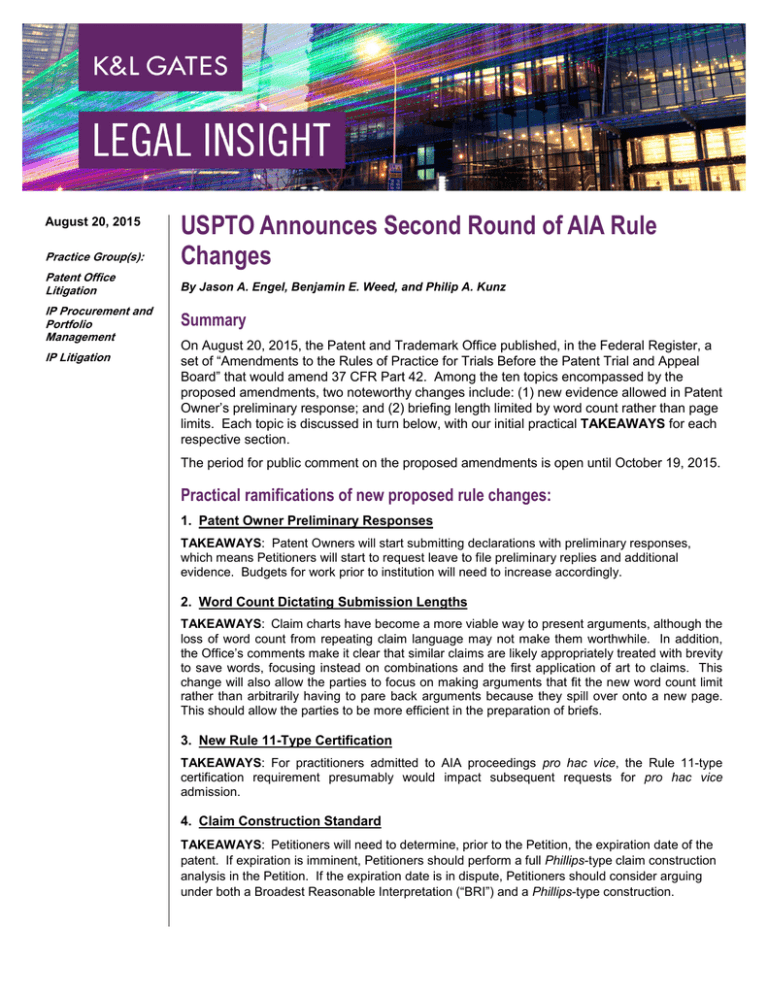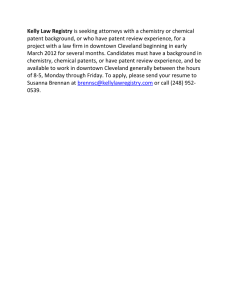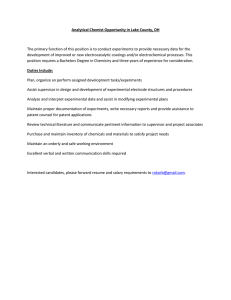
August 20, 2015
Practice Group(s):
Patent Office
Litigation
IP Procurement and
Portfolio
Management
IP Litigation
USPTO Announces Second Round of AIA Rule
Changes
By Jason A. Engel, Benjamin E. Weed, and Philip A. Kunz
Summary
On August 20, 2015, the Patent and Trademark Office published, in the Federal Register, a
set of “Amendments to the Rules of Practice for Trials Before the Patent Trial and Appeal
Board” that would amend 37 CFR Part 42. Among the ten topics encompassed by the
proposed amendments, two noteworthy changes include: (1) new evidence allowed in Patent
Owner’s preliminary response; and (2) briefing length limited by word count rather than page
limits. Each topic is discussed in turn below, with our initial practical TAKEAWAYS for each
respective section.
The period for public comment on the proposed amendments is open until October 19, 2015.
Practical ramifications of new proposed rule changes:
1. Patent Owner Preliminary Responses
TAKEAWAYS: Patent Owners will start submitting declarations with preliminary responses,
which means Petitioners will start to request leave to file preliminary replies and additional
evidence. Budgets for work prior to institution will need to increase accordingly.
2. Word Count Dictating Submission Lengths
TAKEAWAYS: Claim charts have become a more viable way to present arguments, although the
loss of word count from repeating claim language may not make them worthwhile. In addition,
the Office’s comments make it clear that similar claims are likely appropriately treated with brevity
to save words, focusing instead on combinations and the first application of art to claims. This
change will also allow the parties to focus on making arguments that fit the new word count limit
rather than arbitrarily having to pare back arguments because they spill over onto a new page.
This should allow the parties to be more efficient in the preparation of briefs.
3. New Rule 11-Type Certification
TAKEAWAYS: For practitioners admitted to AIA proceedings pro hac vice, the Rule 11-type
certification requirement presumably would impact subsequent requests for pro hac vice
admission.
4. Claim Construction Standard
TAKEAWAYS: Petitioners will need to determine, prior to the Petition, the expiration date of the
patent. If expiration is imminent, Petitioners should perform a full Phillips-type claim construction
analysis in the Petition. If the expiration date is in dispute, Petitioners should consider arguing
under both a Broadest Reasonable Interpretation (“BRI”) and a Phillips-type construction.
USPTO Announces Second Round of AIA Rule Changes
5. Motions to Amend
TAKEAWAYS: It is possible that the duty of candor may be usable to curtail amendments by
submitting art to the Patent Owner even after institution, based on preliminary response
arguments and evidence. Petitioners should consider sending communications to Patent Owners
enclosing art that addresses arguments raised in the preliminary response.
6. Additional Discovery
TAKEAWAYS: It is still of paramount importance that the requested discovery be narrow and
very likely to result in relevant, important information, particularly when it pertains to confidential
information about the Petitioner’s (accused infringer’s) success.
7. Real Party in Interest
TAKEAWAYS: Real party in interest issues should be fleshed out prior to filing the Petition. As
always, make sure to take as conservative an approach as possible with regard to the one-year
limit to file.
8. Multiple Proceedings
TAKEAWAYS: Petitions filed about patents already the subject of AIA review should explain, in
as much detail as possible, the circumstances that warrant instituting an additional review.
9. Oral Hearing
TAKEAWAYS: The Board will entertain requests for oral hearing that deviate from the norm in
terms of technology requests or oral testimony. These requests should be made in the request
for oral hearing. Also, the date for exchange of demonstratives has been moved back to seven
(7) business days before oral hearing, giving the parties more time to resolve objections.
Objectionable slides will thus likely be more difficult to present in oral hearings.
10. Other General Topics (Office-Stated “Catchall”)
TAKEAWAYS: It appears likely that the Office will implement a single judge-institution pilot
program. While preliminary responses remain optional, the Office is apparently encouraging
parties to use them to flesh out issues as early as possible. The Office appears comfortable with
the way it is currently managing its docket. Finally, practitioners should be aware that the Office
intends to use the Office Patent Trial Practice Guide as a tool for implementing changes to AIA
trials, and that any updates to the Office Patent Trial Practice Guide are forthcoming.
Below are highlights from the Office’s proposals for each respective section:
1. Patent Owner Preliminary Responses
The Office proposes amending the rules to allow Patent Owners to submit new testimonial
evidence (as opposed to declarations or depositions generated during other proceedings) with
preliminary responses. Under the proposal, Petitioners would not have a right of crossexamination before institution due to time constraints. To address the potential inequities, factual
disputes would be resolved in favor of the Petitioner for purposes of institution only. The Office
also proposes to amend the rules to allow Petitioners to seek leave to file a single reply to a
preliminary response, including submitting new testimonial evidence with the preliminary reply.
2
USPTO Announces Second Round of AIA Rule Changes
2. Word Count Dictating Submission Lengths
The Office adopted word count limits rather than page limits for: (i) Petitions, (ii) preliminary
responses; (iii) Patent Owner responses; and (iv) reply briefs. Petitions will no longer need be
reviewed to determine whether claim charts contain argument. The Office declined to adjust
word count limits based upon the number of claims challenged since the number of grounds most
often determines the length of a Petition.
The page limits to word count conversions are:
Relevant Submissions
Pages
Petitions, Preliminary Responses, Patent Owner 60
Responses for IPR and Derivation Proceedings
Petitions, Preliminary Responses, Patent Owner 80
Responses for CBM and PGR Proceedings
Replies to Patent Owner Responses
25
Words
14,000
18,700
5,600
3. New Rule 11-Type Certification
The Office proposed to amend 37 C.F.R. § 42.11 (regarding the duty of candor) to require a Rule
11-type certification for all papers filed in proceedings before the Office. This proposed
amendment would include provisions for sanctions in connection with such papers, which
misconduct could be reported to the OED. USPTO Director Michelle Lee stated in her blog that
such a requirement would “give the USPTO a more robust means with which to police
misconduct.”
4. Claim Construction Standard
The Office adopted the comments favoring the retention of a broadest reasonable interpretation
(“BRI”) claim construction standard. The Federal Circuit has affirmed that standard in In re
Cuozzo Speed Techs., LLC based on the history of that standard in the PTO and the ability to
1
amend claims. Notwithstanding, the Office proposed that a Phillips-type claim construction
standard is appropriate for patents that will expire before the issuance of a final written decision.
The Office found it unworkable to allow a Phillips-type construction where Patent Owners elect to
forego claim amendments, but solicited comments regarding solutions for where a Patent Owner
chooses to forego the right to amend claims in AIA proceedings.
5. Motions to Amend
The Office’s position is that the Patent Owner bears the initial burden to establish a prima facie
case of patentability over the art of record and any art submitted pursuant to the duty of candor or
supplied by the Petitioner. The Patent Owner must also show why the amended claims are equal
in scope or narrower than the issued claims in all respects, and that the substitute claims must be
narrower than the issued claims in all respects. Once a prima facie showing of patentability is
made, the burden shifts to the Petitioner to show unpatentability.
Among several comments related to Motions to Amend, the Office:
• Does not intend to seek the assistance of the examining corps with regard to motions to
amend.
1
No. 2014-1301, 2015 WL 4097949, at *7-8 (Fed. Cir. July 8, 2015)
3
USPTO Announces Second Round of AIA Rule Changes
• Declined to change the rules regarding the number of substitute claims allowed or the
showings required to submit multiple substitute claims.
• Addressed Patent Owner estoppel in response to a comment that 37 C.F.R. § 42.73(d)(3)
precludes a Patent Owner from obtaining a claim that could have been made in a motion to
amend. The Office noted that the rule does not prohibit such action; instead, it prohibits
obtaining a claim that is not patentably distinct from a finally refused or canceled claim.
• Noted that a Patent Owner, who continues to enforce claims it voluntarily cancelled before
obtaining a final written decision, may be subject to sanctions in the district court, and may
face investigation by the OED, but that the Office would nonetheless not cancel claims before
issuance of the final written decision.
6. Additional Discovery
The Office will continue to apply the factors from Garmin v. Cuozzo, when considering whether to
2
allow for additional discovery. The Office also noted that the Garmin factors are flexible, and
that the parties are permitted to present different factors as appropriate on a case-by-case basis.
The one-year trial schedule will still be emphasized.
The Office declined an invitation to permit discovery of evidence of non-obviousness (e.g.,
commercial success) in all cases. The Garmin factors will continue to govern requests for
discovery of such evidence of non-obviousness on a case-by-case basis. The Office agreed that
some showing of a nexus between the claims of the patent and an accused product is necessary
in the interest of justice. The Office also declined to adopt a rule to permit interrogatories or
document requests in all cases.
7. Real Party in Interest
The Office will allow Patent Owners to bring challenges based on real party in interest at any time
during the proceeding, but prefers such challenges to occur early in the proceedings. The
challenges will be decided on a case-by-case basis. The Office also declined to require
Petitioners to provide, for example, joint defense agreements or the identification of parties
participating in the preparation of a Petition. The additional discovery rules will continue to
govern proceedings. Clerical errors in identifying real parties in interest may be corrected without
affecting the filing date, but allowing Petitioners to correct other errors would violate 35 U.S.C. §
312(a), which requires a Petition to identify all real parties in interest without qualification. The
Office also clarified that the burden of proof with regard to standing lies with the Petitioner.
8. Multiple Proceedings
The Office noted that the Board has broad discretion in managing multiple proceedings (AIA
trials, reexaminations, and reissues) directed to a single patent. The Board declined to institute a
rule requiring Petitioners to self-identify repetitive challenges. Thus, the Office does not propose
to amend the rules regarding managing multiple proceedings at this time. The Office will continue
to determine whether to stay reexamination proceedings or AIA trials when co-pending
proceedings exist on a case-by-case basis taking into consideration the overlap of issues and the
stage of the co-pending proceedings to try to avoid duplicative work for the Office. Consolidation
and allowing follow-on proceedings will also continue to be decided on a case-by-case basis. It
2
IPR2012-00001. These factors generally address whether (1) a party possesses more than a possibility/allegation, (2) a
party is seeking underlying litigation positions, (3) the equivalent information can be otherwise generated, (4) the requests
are facially clear, and (5) the requests are not overly burdensome to answer.
4
USPTO Announces Second Round of AIA Rule Changes
declined to bind all Petitioners to the outcome of a first-filed Petition, and also declined to apply a
“rebuttable presumption” of duplication if overlapping prior art is raised in a second Petition.
9. Oral Hearing
The Office will continue to consider requests for oral hearings on a case-by-case basis, but does
not expect that oral testimony is needed in every case where there is conflicting testimony. The
format for the presentation of live testimony is left up to the panel.
The Office changed its rules to require the exchange of demonstrative exhibits seven (7)
business days before the final hearing date.
The Office is planning to update its ability to hold hearings in regional offices.
In response to a request for a rule that parties be allowed to obtain recesses in oral hearings to,
for example, discuss issues with experts, the Office noted that panels will hear requests for
recess on a case-by-case basis.
10. Other General Topics (Office-Stated “Catchall”)
• The Office did not adopt any rule change regarding the Board’s discretion to determine issues
of unpatentability even after settlement.
• The Office is not going to change its use of partial institution as a docket management tool. It
understands the different impacts of using references in different statutory classes, particularly
where some references may be sworn behind, and will continue to try to strike an appropriate
balance with partial institutions.
• The Office may separately seek comments on a pilot program under which institution
decisions will be made by a single Administrative Patent Judge (“APJ”), with two additional
APJs being assigned for the trial phase.
• The Office requested further comment on 37 C.F.R. § 42.53(d)(4) regarding deposition
practice, that is, reducing the amount of lead time for which a deposition notice is required.
• The Office declined to make preliminary responses mandatory with regard to certain issues
(claim construction and antedating), but noted that the new ability to file testimonial evidence
(see Section 1) may motivate Patent Owners to address such issues early in the proceedings.
• The Office also noted that it intends to amend the Office Patent Trial Practice Guide in an
unspecified way with regard to additional discovery, live testimony, and confidential
information. We will provide an update if and when those changes are implemented.
5
USPTO Announces Second Round of AIA Rule Changes
Authors:
Benjamin E. Weed
benjamin.weed@klgates.com
+1.312.781.7166
Philip A. Kunz
philip.kunz@klgates.com
+1.312.807.4294
Jason A. Engel
jason.engel@klgates.com
+1.312.807.4236
Anchorage Austin Beijing Berlin Boston Brisbane Brussels Charleston Charlotte Chicago Dallas Doha Dubai Fort Worth Frankfurt
Harrisburg Hong Kong Houston London Los Angeles Melbourne Miami Milan Moscow Newark New York Orange County Palo Alto Paris
Perth Pittsburgh Portland Raleigh Research Triangle Park San Francisco São Paulo Seattle Seoul Shanghai Singapore Spokane
Sydney Taipei Tokyo Warsaw Washington, D.C. Wilmington
K&L Gates comprises more than 2,000 lawyers globally who practice in fully integrated offices located on five
continents. The firm represents leading multinational corporations, growth and middle-market companies, capital
markets participants and entrepreneurs in every major industry group as well as public sector entities, educational
institutions, philanthropic organizations and individuals. For more information about K&L Gates or its locations,
practices and registrations, visit www.klgates.com.
This publication is for informational purposes and does not contain or convey legal advice. The information herein should not be used or relied upon in
regard to any particular facts or circumstances without first consulting a lawyer.
© 2015 K&L Gates LLP. All Rights Reserved.
6


